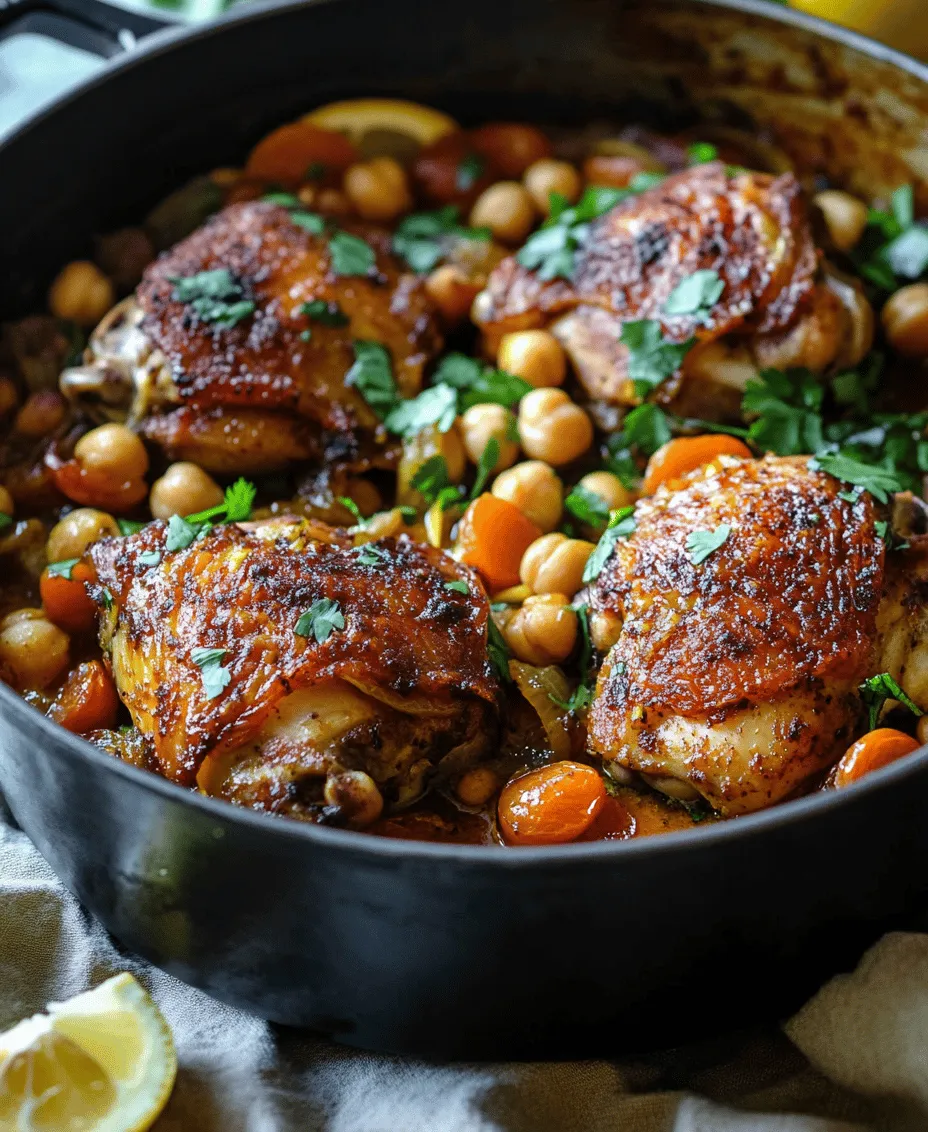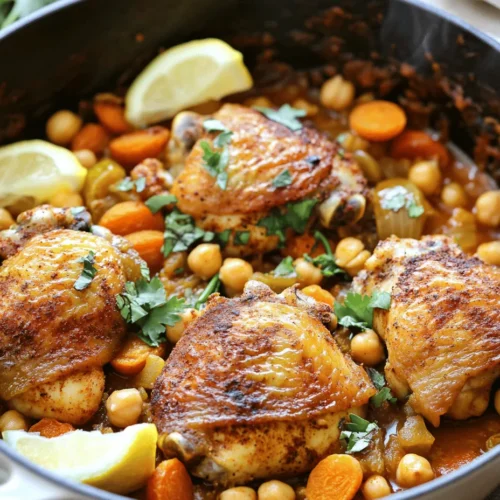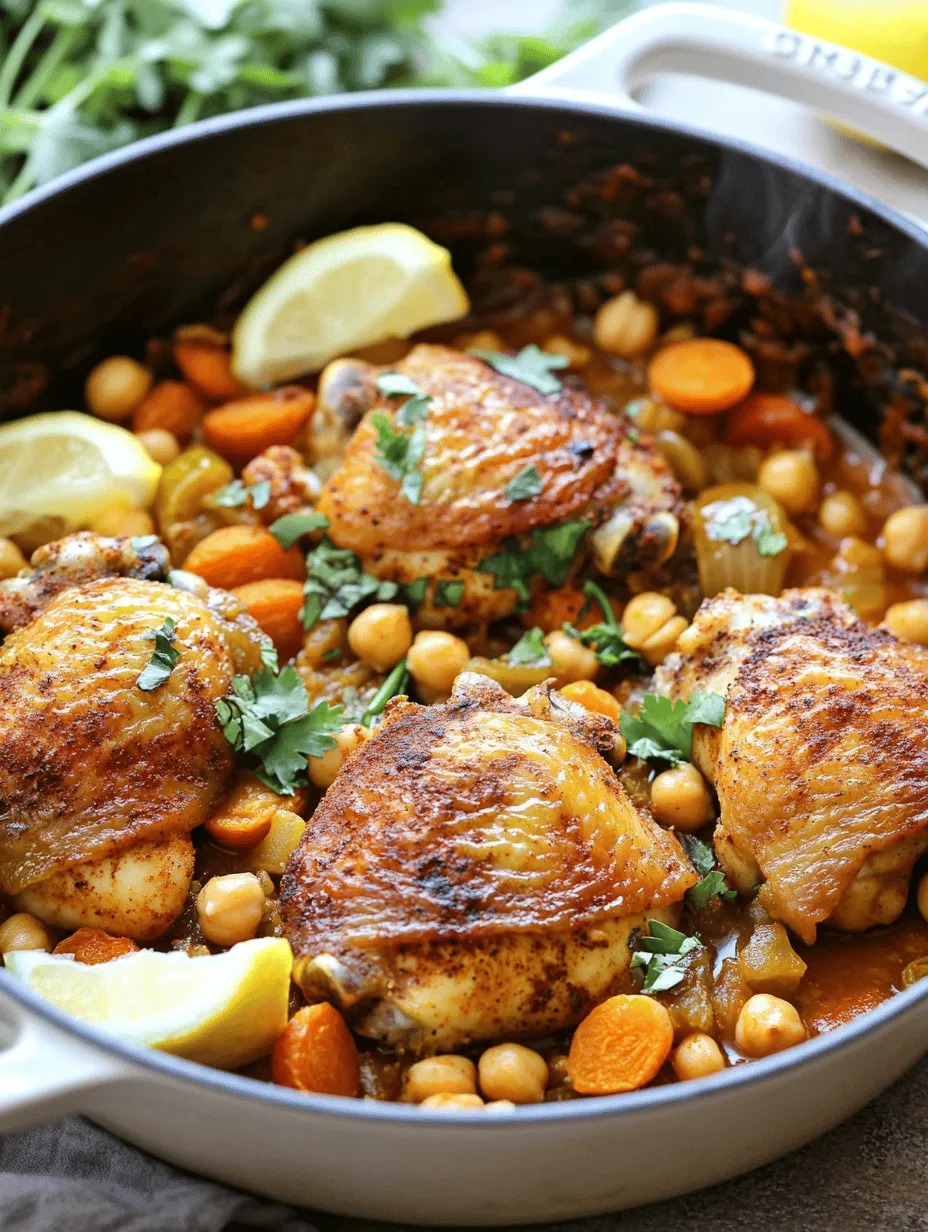Introduction
Moroccan cuisine is a vibrant tapestry woven from a rich history of cultural exchange, showcasing a fusion of Berber, Arab, and Mediterranean influences. Known for its bold flavors and aromatic spices, Moroccan cooking offers a sensory delight that transports your palate to the bustling markets of Marrakech or the serene streets of Fez. Among its many culinary gems, Moroccan Spiced Chicken stands out as a dish that encapsulates the essence of this enchanting cuisine: tender chicken marinated in a medley of spices, creating a harmonious blend of textures and flavors that is both comforting and exotic.
As you embark on this culinary journey, expect to discover the secret behind the aromatic spices that give Moroccan Spiced Chicken its distinctive character. This dish not only tantalizes your taste buds but also nourishes your body with wholesome ingredients. In this article, we will delve into the intricacies of Moroccan cuisine, explore the allure of Moroccan Spiced Chicken, introduce its essential ingredients, and provide a step-by-step guide to preparing a dish that is sure to impress your family and friends.
Understanding Moroccan Cuisine
Moroccan cooking traditions are a reflection of the country’s diverse cultural heritage. The cuisine is characterized by its use of spices, which play a pivotal role in flavoring dishes. Spices such as cumin, coriander, saffron, and cinnamon are staples in Moroccan kitchens, each contributing unique notes that elevate the overall dish. The art of blending spices, known as “ras el hanout,” is a defining feature of Moroccan culinary practice, often resulting in intricate flavor profiles that are both intriguing and satisfying.
In addition to spices, Moroccan cuisine frequently incorporates fresh herbs, fruits, and vegetables, creating a colorful and nutritious palette. Ingredients such as olives, preserved lemons, apricots, and chickpeas are commonly used, showcasing the country’s agricultural bounty and the influence of its Mediterranean climate. The preparation methods often involve slow-cooking techniques, allowing flavors to meld together, resulting in dishes that are rich and deeply satisfying.
The Allure of Moroccan Spiced Chicken
Moroccan Spiced Chicken is a delightful representation of the country’s culinary identity. This dish is traditionally prepared with chicken thighs, which are marinated in a vibrant mix of spices and herbs, then slow-cooked to achieve tender, succulent meat. The balance of flavors is truly remarkable; the savory notes of the spices are complemented by the sweetness of dried fruits and the earthiness of chickpeas.
This dish holds cultural significance in Morocco, often enjoyed during family gatherings, celebrations, and special occasions. The combination of spices not only tantalizes the taste buds but also provides various nutritional benefits. Ingredients like chicken, chickpeas, and dried apricots contribute protein, fiber, and essential vitamins and minerals, making it a wholesome meal option.
Essential Ingredients for Moroccan Spiced Chicken
To create a truly authentic Moroccan Spiced Chicken, it’s vital to understand the key ingredients that bring this dish to life. Here’s a breakdown of what you’ll need:
1. Chicken Thighs: Bone-in, skin-on chicken thighs are recommended for this recipe. The bone adds flavor, and the skin helps retain moisture during cooking, ensuring tender meat that practically falls off the bone.
2. Olive Oil: A staple in Mediterranean cooking, olive oil adds richness to the dish while helping to sauté the aromatics and spices. Its healthy fats also enhance the overall flavor profile.
3. Aromatics: The base of the dish is built upon finely chopped onions and minced garlic. These ingredients provide depth and complexity, infusing the chicken with a savory foundation.
4. Spices: The star of the show is undoubtedly the spice blend. Here’s a closer look at each spice:
– Cumin: Earthy and warm, cumin is essential for its bold flavor that complements the chicken beautifully.
– Coriander: With citrusy undertones, coriander adds brightness and balances the richness of the other spices.
– Smoked Paprika: This spice brings a subtle smokiness and vibrant color to the dish, enhancing its visual appeal.
– Cinnamon: A pinch of cinnamon introduces warmth and sweetness, harmonizing with the other spices.
– Ginger: Fresh or ground ginger adds a spicy kick that invigorates the dish, making it refreshing.
– Cayenne Pepper: For those who enjoy heat, cayenne pepper can be adjusted to taste, providing a fiery finish.
5. Chickpeas: Adding protein and a hearty texture, chickpeas not only make the dish more filling but also absorb the rich flavors of the spices.
6. Dried Apricots: These sweet morsels provide a delightful contrast to the savory spices and add a chewy texture that enhances the overall experience.
7. Lemon Zest: A touch of lemon zest brightens the dish, cutting through the richness and adding a refreshing note.
8. Optional Ingredients: Depending on dietary preferences, feel free to experiment with other ingredients. For example, you can substitute chicken with tofu for a vegetarian version or use different nuts and dried fruits to personalize the dish.
Step-by-Step Guide to Preparing Moroccan Spiced Chicken
With the essential ingredients in hand, you’re ready to embark on the cooking process. Here’s a step-by-step guide to preparing Moroccan Spiced Chicken that will lead you to culinary success:
1. Marinate the Chicken: Begin by creating a marinade with olive oil, minced garlic, and the spice blend. Coat the chicken thighs generously and let them marinate for at least an hour, or preferably overnight in the refrigerator. This step is crucial as it allows the flavors to penetrate the meat, resulting in a more flavorful dish.
2. Sauté the Aromatics: In a large skillet or tagine, heat a splash of olive oil over medium heat. Add the chopped onions and cook until they become translucent. This step builds the foundation of flavor that will enhance the chicken.
3. Brown the Chicken: Once the onions are ready, add the marinated chicken thighs to the skillet. Sear them on both sides until golden brown. This not only adds flavor but also helps to lock in moisture.
4. Add Chickpeas and Dried Apricots: After browning the chicken, stir in the chickpeas and dried apricots, allowing them to mingle with the spices and onions.
5. Simmer: Pour in enough water or chicken broth to nearly cover the chicken. Bring the mixture to a gentle simmer, then reduce the heat to low, cover, and let it cook slowly. The longer it simmers, the more the flavors will develop, creating a dish that is warming and comforting.
As you work through these steps, you will find yourself immersed in the delightful aromas of Moroccan spices wafting through your kitchen, setting the stage for an unforgettable dining experience. The combination of tender chicken, hearty chickpeas, and sweet apricots creates a meal that is not only satisfying but also a celebration of Moroccan culinary traditions. Stay tuned for the continuation of this journey, where we will explore additional tips and techniques to perfect your Moroccan Spiced Chicken.

Preparing the Chicken
Before diving into the cooking process, it’s essential to prepare the chicken properly. Start with skin-on, bone-in chicken pieces, as they lend themselves beautifully to this recipe. Rinse the chicken under cold water and pat it dry using paper towels. This step is crucial because moisture on the surface of the chicken can prevent it from searing properly, which is vital for achieving that delicious, golden-brown exterior.
Importance of Drying and Seasoning
Drying the chicken not only prepares it for a perfect sear but also allows the seasoning to adhere better. After patting the chicken dry, season it generously with salt and pepper. Salt not only enhances flavors but also draws out moisture, which can help create a crust when seared. For added depth, consider rubbing the chicken with a bit of olive oil and the Moroccan spice blend ahead of time, allowing it to marinate for at least 30 minutes, or ideally, overnight in the refrigerator. This will ensure the spices penetrate the meat and infuse it with flavor.
Tips for Achieving a Perfect Sear
Searing chicken requires the right heat and timing. Use a heavy-bottomed skillet or Dutch oven to ensure even heat distribution. Preheat your skillet over medium-high heat until it’s hot, then add a couple of tablespoons of oil. Once the oil shimmers, it’s ready. Place the chicken skin-side down in the pan. Avoid overcrowding the pan, as this can lower the temperature and lead to steaming rather than searing. Sear for about 5-7 minutes without moving the chicken, then flip it and sear the other side for an additional 5 minutes.
Searing the Chicken
Searing isn’t just about cooking the chicken; it’s a transformative process that enhances flavor through the Maillard reaction, which occurs when proteins and sugars in the food react to heat. This reaction creates complex flavors and a rich, deep color.
Techniques for Getting the Skin Crispy and Golden
To achieve perfectly crispy skin, ensure the chicken skin is dry before it touches the hot oil. Additionally, use a combination of medium-high heat to start and then adjust the heat to prevent burning while ensuring thorough cooking. If you’re using bone-in pieces, like thighs or drumsticks, consider covering the pan for a few minutes after flipping to help cook through while still maintaining that crispy exterior.
The Impact of Searing on Flavor Development
Searing the chicken is crucial because it develops a robust flavor that enriches the overall dish. The browned bits left in the pan, often called fond, are packed with flavor and will be deglazed later to add depth to your sauce.
Sautéing Aromatics
Once the chicken is perfectly seared, it’s time to sauté the aromatics. Remove the chicken from the skillet and set it aside on a plate. In the same skillet, add more oil if necessary, and then toss in diced onions. Cook the onions over medium heat until they become translucent, about 4-5 minutes.
Timing and Heat Management for Onions and Garlic
After the onions are softened, add minced garlic, stirring frequently to prevent burning, as garlic can turn bitter quickly. Cooking the onions for the right amount of time ensures they develop sweetness, while the garlic will provide a fragrant base for the dish.
How to Achieve the Right Fragrance
The aroma of sautéing onions and garlic fills the kitchen with warmth and sets the tone for the flavorful Moroccan spices to follow. Once fragrant, it’s time to move on to the next step.
Adding Spices
The next step is to add the Moroccan spice blend. This typically includes spices such as cumin, coriander, cinnamon, paprika, and turmeric.
The Art of Toasting Spices and Enhancing Flavor
Toasting the spices in the hot skillet for about a minute before adding liquid is critical. This process releases their essential oils and enhances their flavors, creating a richer and more aromatic dish. Stir the spices continuously to prevent burning, and as they begin to release their fragrance, you’ll know they are ready.
Suggested Spice Adjustments Based on Personal Taste
Feel free to adjust the spice quantities based on your preferences. If you enjoy more heat, consider adding cayenne pepper or harissa for a spicy kick. For a more aromatic profile, a touch of cardamom can also work wonders.
Incorporating Remaining Ingredients
After toasting the spices, it’s time to layer in the remaining ingredients: diced tomatoes, chicken broth, and any additional vegetables you’d like to include, such as bell peppers or carrots.
How to Layer Flavors Effectively
Layering flavors is an essential technique in cooking. Start with the base of sautéed onions and garlic, followed by the toasted spices, and then add the tomatoes and broth. This method allows each ingredient to contribute to the final flavor profile, resulting in a harmonious and complex dish.
Importance of Simmering for Tenderness
After incorporating the ingredients, return the seared chicken to the skillet. Bring the mixture to a gentle simmer, then cover the skillet with a lid. Simmering allows the chicken to absorb the flavors of the sauce while becoming tender and juicy.
Simmering to Perfection
Timing and Temperature Tips for Optimal Results
Let the chicken simmer for about 30-40 minutes, depending on the size of the pieces. A low and slow approach will ensure the meat is cooked through and tender without drying out. You can check the chicken’s doneness by inserting a meat thermometer into the thickest part; it should read 165°F (75°C) when fully cooked.
Serving Suggestions for Moroccan Spiced Chicken
Once your Moroccan spiced chicken is cooked to perfection, it’s time to think about serving.
Recommended Side Dishes: Couscous, Crusty Bread, or Rice
This dish pairs beautifully with fluffy couscous, which absorbs the rich sauce and balances the spices. Alternatively, serve it with crusty bread for dipping or a side of fragrant rice to soak up the flavorful sauce.
Ideas for Garnishing: Fresh Cilantro and Lemon Wedges
For a burst of freshness, consider garnishing the dish with freshly chopped cilantro and lemon wedges. The acidity from the lemon will brighten the flavors, while the cilantro adds a lovely herbaceous note.
Presentation Tips for an Attractive Serving Style
When plating, arrange the chicken pieces attractively on a serving platter and spoon some sauce over the top. Scatter the garnishes around for visual appeal, and consider serving with additional spice blends or a drizzle of olive oil for a touch of elegance.
Conclusion
The Moroccan spiced chicken is a dish that brings vibrant flavors and cultural significance to your dining table. With its aromatic spices and tender meat, it’s a wonderful way to explore the rich culinary traditions of Morocco.
This recipe encourages you to experiment with spices and ingredients, inviting you to unleash your creativity in the kitchen. Cooking is not just about following a recipe; it’s about the joy of bringing people together and sharing a meal that is both satisfying and nourishing.
So, gather your loved ones, serve this delightful dish, and let the aromas transport you to the heart of Morocco. Enjoy the process of cooking, and remember, every meal is an opportunity to create lasting memories.



